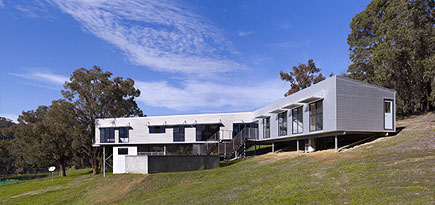
![]() STEEL PRODUCTS PLAY AN INTEGRAL ROLE IN REDUCING SOCIETY’S GREENHOUSE GAS EMISSIONS.
STEEL PRODUCTS PLAY AN INTEGRAL ROLE IN REDUCING SOCIETY’S GREENHOUSE GAS EMISSIONS.
THE ROLE OF STEEL IN A CARBON CONSTRAINED WORLD
The global response to climate change is expected to involve numerous new clean energy technologies.
Many of these, such as wind, wave and tidal power, carbon capture and storage, are steel intensive.
BlueScope’s steel products will play an integral role in reducing society’s greenhouse gas emissions, including:
- as components in renewable energy infrastructure, such as wind towers, gas pipelines, solar power plants). For example, a typical wind turbine relies on more than 200 tonnes of iron and steel in its manufacture. Many of a wind turbine’s structural components are made of steel plate, such as BlueScope Steel’s XLERPLATE®, and cannot be economically built with alternative materials;
- in more sustainable transport infrastructure (e.g. trains, buses and, lighter, more efficient steel products for cars);
- greener, more energy efficient buildings.
Adaptation to the impact of climate change also requires steel.
- Steel is an essential material in new public transport infrastructure, and in lighter weight, hybrid and electric cars;
- Climate change may increase the frequency of bushfire events. BlueScope Steel products such as COLORBOND® steel fencing products and SURELINE® steel power poles are an ideal solution in areas which are bushfire prone;
- Innovative products such as BlueScope’s COLORBOND® Coolmax® coated steel roofing could help reduce the annual cooling energy costs of buildings by up to 7.5% by maximising the thermal performance of the building.
Importantly, steel is 100% recyclable and its life is potentially infinite.
BlueScope Steel’s Greenhouse Policy Principles
We work hard to maintain our competitiveness. In contrast, many overseas steelmakers receive subsidies and other support to help them export. Policy that puts higher costs on Australian steelmakers but not on overseas steelmakers risks undermining our competitiveness.
BlueScope has developed the following greenhouse gas policy principles against which it will assess policies aimed at reducing GHG emissions.
Global issue - Reducing greenhouse gas emissions is a global problem that requires a global approach.
Least cost - Australia should adopt policy that achieves emissions targets at least cost. Putting a price on carbon which is visible to consumers and producers through a market mechanism (emissions trading or carbon tax) is likely to drive least cost abatement.
Fair go - The competitiveness and financial viability of Australia’s trade exposed steel industry must not be eroded. We cannot place our industries at a disadvantage to the rest of the world. Transitional measures for trade exposed industries - including the steel industry - will be essential for as long as our global competitors (India, China, US, Japan, Korea and Taiwan) do not face comparable carbon costs.
Cut green tape - A single national carbon policy should be the goal of governments. Complementary policy measures adopted by Federal and State governments must be effective, least cost and address recognised market failures. These policies must avoid market distortions or perverse incentives, overlap and unnecessary compliance costs and regulatory burden.
Reinvest - Revenue raised by a carbon price should be earmarked for investment in greenhouse gas abatement and assistance for households and industry. Policy should provide incentives for research & development and investment in abatement, including appropriate recognition for early movers.
No leakage - Policy must not lead to carbon leakage, by which Australian production is simply replaced by foreign production that may, in fact, be less carbon efficient.
One in, all in - Policy should be comprehensive, including all sectors of the economy (and imports where appropriate), and be transparent.
Investment certainty - Policy must recognise the very long time horizons for investment in the steel industry, including for potential next generation lower emissions iron and steelmaking technology.

